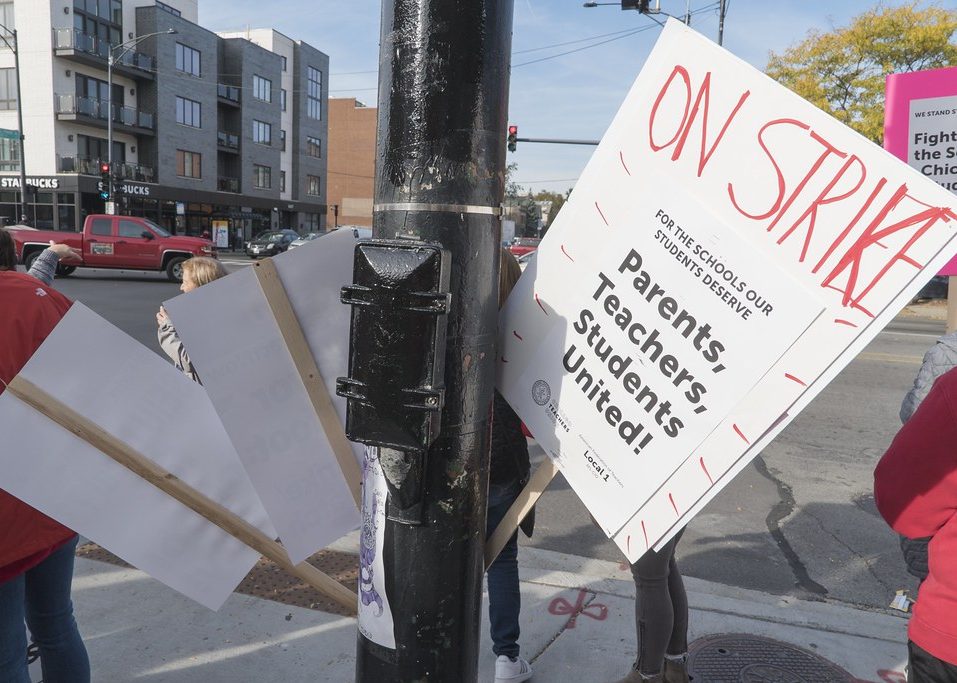What the Chicago Teachers Union Achieved
The Chicago Teachers Union approved the contract that they went on strike for last month. While it’s far from perfect, the contract includes huge victories on multiple fronts. Teachers around the country should study what the CTU achieved — and how they organized within the union itself to achieve it.

Milwaukee Teachers Association / Flickr
Chicago’s teachers have given labor a much-needed lesson in organizing for the twenty-first century, as it did in 2012. Building on the energy of “red state” teacher walkouts and in a union transformed and led by reformers in the Caucus of Rank and File Educators (CORE), the CTU has created a new milestone for the movement. Much has been written about the strike, which ended last month. But three of the many achievements of this strike deserve attention they’ve not yet received: two about education, one about labor more generally.
First, Chicago’s teachers have won dozens of contract provisions critical to re-professionalizing teachers’ work, like rules to make the teacher evaluation process fair, pushing back on its frequent abuse by administrators who use the process to intimidate rather than support teachers. Details count in how and when teachers are observed, and a strong contract makes sure teachers have an opportunity to answer “gotcha” reviews by administrators.
This right has been strengthened by requiring administrators to schedule post-evaluation conferences at times that are conducive for both parties to make the conversation worthwhile. As corporate control over public education has increased, teachers have become increasingly subject to managerial despotism. With this contract, the movement to defend teaching as a profession has shifted to the offense.
CTU foregrounded special education services in contract proposals, and the visible leadership of special education teachers in the lead-up to the strike and during it challenged one of capitalism’s most pernicious ideological victories: widespread acceptance of a “survival of the fittest” ethos, a kind of social Darwinism used to justify inequality, poverty, and unemployment. Bipartisan education policies have intensified academic pressures on all students, ignoring what we know about child development and narrowing the definition of “normal” achievement and growth. Meanwhile, the shredding of the social safety net has intensified demands on schools and teachers.
Schools have seen the convergence of these factors’ effects in a dramatic increase in the numbers of students requiring special education, a disproportionate number of whom are black and brown. As that number has grown, the supports they need in schools have diminished, especially in “high-needs” schools, which are hard to staff because the work is draining.
The wins in this contract create more stable learning conditions for special ed students in several ways. One is creating a pool of substitute teachers who are trained to work with special needs students. All substitutes will receive training on working with students in special education and English learners. And special ed teachers will be the last called on to “cover classes” when other teachers are out and the substitute doesn’t show up.
But perhaps the most important aspect of this strike is one mostly ignored: how the union has reinvented itself after its electrifying 2012 strike, as it experienced years of unrelenting attacks, including attempts to gut teachers’ pensions and cutbacks in services to students. Tensions within a union about how best to balance competing demands for human and financial resources are unavoidable, as is the tendency for members to feel officers and staff long removed from the workplace don’t understand what work has become. The CTU was able to put these disagreements to productive use because of the leadership’s commitment to democracy and CORE’s capacity to be a space for members to thrash out political differences.
Tensions within the union were reflected in the recent growth of another caucus, Teachers First, which attacked the union’s leadership from the right. They also manifested in disagreements within CORE about whether members’ voices were being heard about how to direct union resources in organizing and electoral activity. The strike has not eliminated those tensions, which arise even in the most democratic spaces because of differing pressures and responsibilities of members and elected officers. Still, the CTU has shown us that union democracy is as fragile as it is essential and can be sustained even when enormous demands are made on leaders and members.
Now that the contract has been approved overwhelmingly, the union and CORE face new challenges. They must educate a newly energized base to defend the contract in schools and buttress the loyalty of members who may have voted for the contract but are dissatisfied with how much was won in comparison to how many days of pay were lost.
But they will be able to draw on the solidarity developed among members during the strike on the lines, as well as relationships with new community, parent, and student allies brought into the union’s political orbit during the strike. The labor movement in Chicago has been altered by this strike, held jointly with SEIU Local 73, and the CTU has faced down Mayor Lightfoot and Chicago’s ruling class.
Though we may wish we could, we can’t clone the CTU, CORE, or Chicago’s teachers. But teachers around the country can learn from them. And thank them for showing us what’s possible. Again.